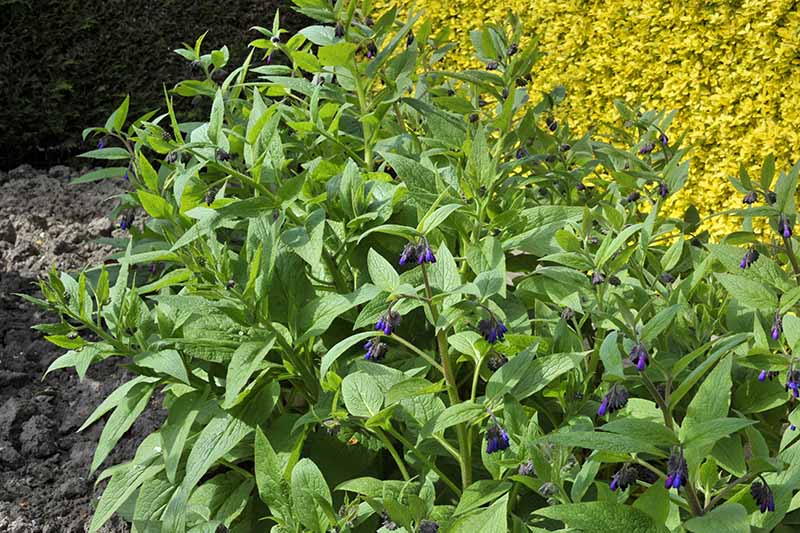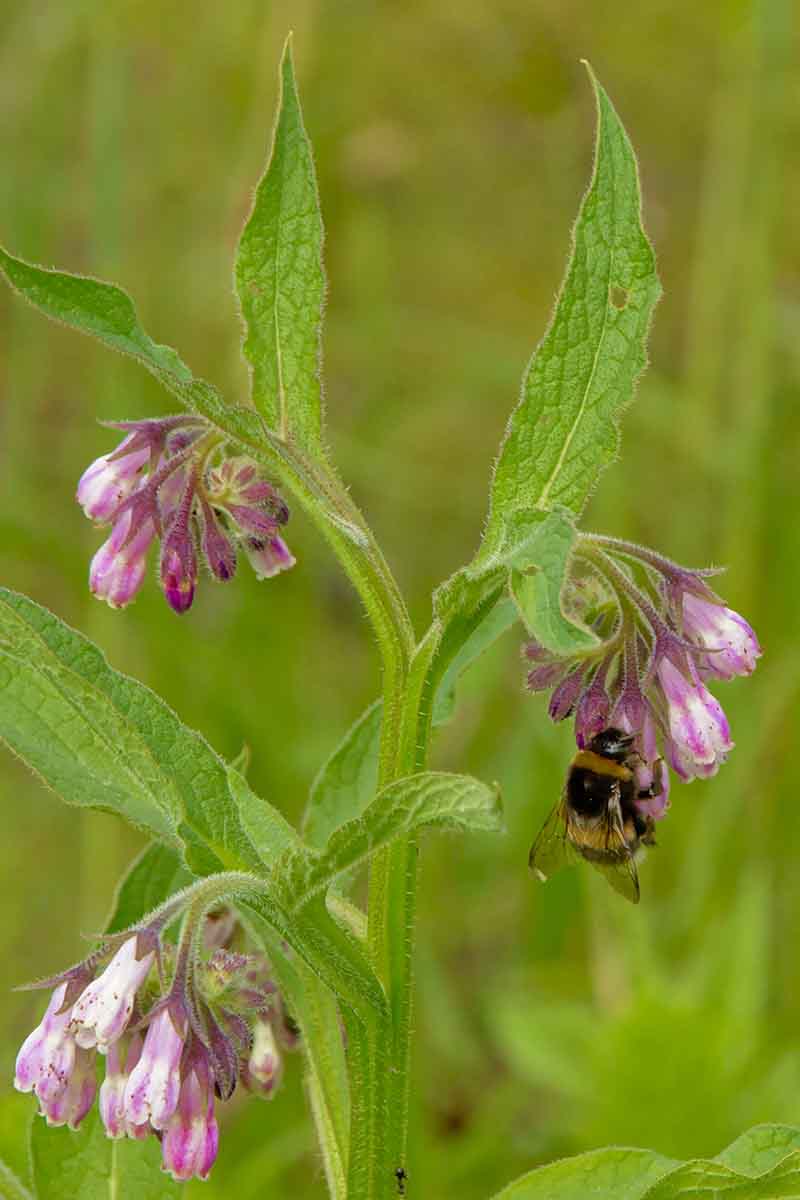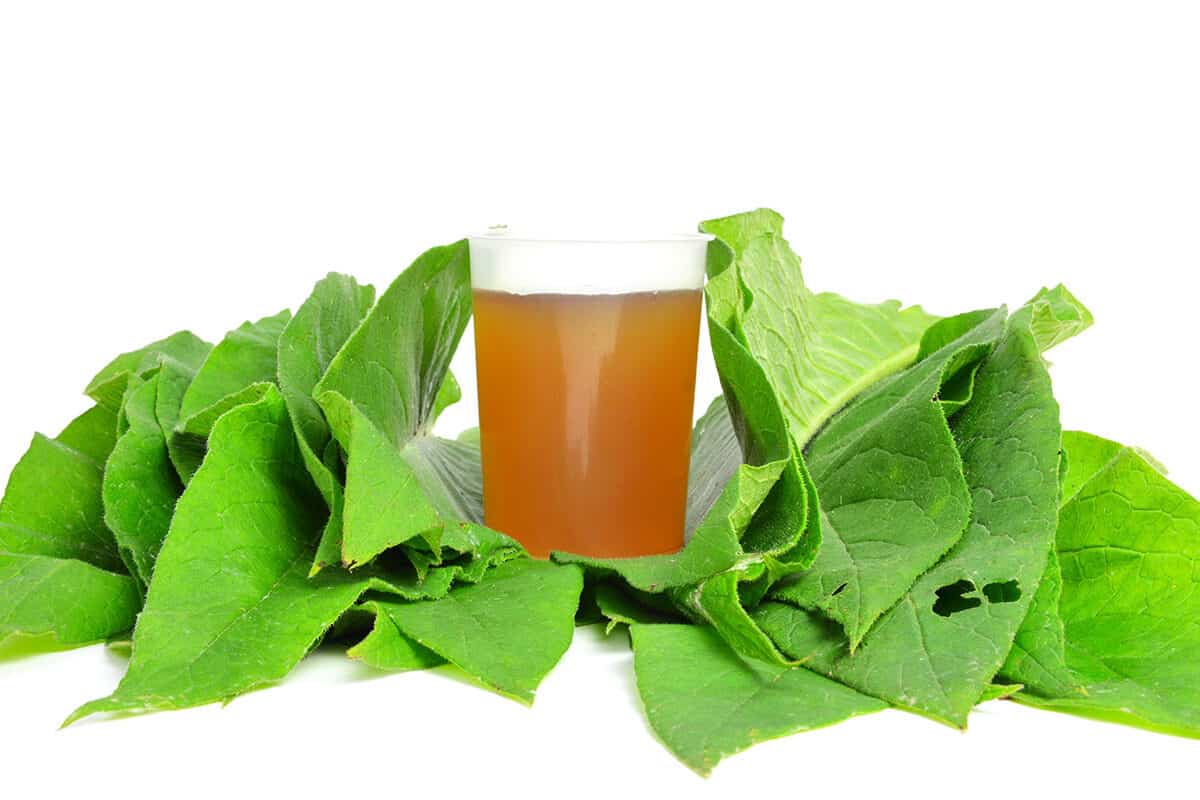Fertilizing gardens can be costly, especially if you are an organic grower. And even fertilizers labeled organic may contain some undesirable chemicals. They are also packaged in plastic, made in factories, and shipped long distances.
But what if I told you that you can use comfrey plants from your own garden to make your own all-natural fertilizer at home?
We link to vendors to help you find relevant products. If you buy from one of our links, we may earn a commission.
This hardy perennial grows quickly and easily. It has pretty flowers, and best of all, it can give you free fertilizer that is full of nutrients that you can use all season.
Comfrey tea is an organic fertilizer that can provide excellent nutrition for your plants, especially flowering and fruiting varieties. It contains high levels of potassium, nitrogen and phosphorus which are necessary for productive plants However, comfrey tea needs to be diluted properly before using it on your plants This article will explain how to dilute comfrey tea to get the maximum benefits.
What is Comfrey Tea?
Comfrey tea is made by steeping comfrey leaves in water. This allows the nutrients in the leaves to be extracted into the water, creating a concentrated liquid fertilizer.
The most common method is to fill a container with freshly cut comfrey leaves, add water just to cover the leaves, and allow it to steep for 2-6 weeks. This produces a dark, concentrated “tea” that needs to be diluted significantly before using on plants
Another method is to layer chopped leaves and water in a container, without fully submerging the leaves. This aerobic process produces a lighter tea in 1-2 weeks.
Either way, the finished comfrey tea is packed with essential nutrients that plants need – potassium for fruit production, nitrogen for healthy growth, and phosphorus for root and flower development. But it needs diluting for safe usage.
Why Dilute Comfrey Tea?
While the nutrients in comfrey tea are beneficial for plants, the tea is too strong to use undiluted. Applying pure comfrey tea can damage or even kill plants.
Some key reasons you need to dilute comfrey tea before using it:
-
It has a very high nutrient concentration that can “burn” plants if used undiluted. Always test on a small area first.
-
The decomposing leaves alter the pH making the tea acidic. Diluting buffers the pH for plant safety.
-
Undiluted comfrey tea may contain toxins from certain comfrey species that can be harmful in large concentrations.
-
Some additional bacteria or mold can grow on the leaves during steeping. Diluting minimizes any potential issues from microbes.
-
It has a strong odor that will be less noticeable when mixed into water.
Diluting comfrey tea moderates the nutrient levels and creates a safe, beneficial fertilizer for your garden plants.
How Much to Dilute Comfrey Tea
Most recommendations are to dilute comfrey tea at a ratio of 1 part comfrey tea to 10 parts water. However, the exact dilution rate depends on the concentration of your finished tea.
-
Stronger concentration: Dilute at a 1:15 or 1:20 ratio if your tea is very dark brown or black.
-
Medium concentration: Dilute at 1:10 to 1:15 if your tea is medium to dark brown.
-
Lighter concentration: You may only need a 1:5 dilution if your tea is lighter brown.
The more you dilute the tea, the more applications your batch will cover but the less nutrients each application will provide. Find the right balance for your needs.
A good rule of thumb is to start with a 1:10 dilution and adjust from there if needed. It’s easier to increase concentration than deal with burned plants from too strong a mix!
How to Dilute Comfrey Tea
Follow these simple steps for diluting your finished comfrey tea before using it in the garden:
-
Assess the concentration – Check the color and thickness of your finished tea to estimate the ideal dilution rate, as explained above.
-
Get two containers – You’ll need one container for measuring out the concentrated tea and another larger container for diluting it. Use watering cans, buckets, or jugs.
-
Add tea and water – Add 1 part comfrey tea to at least 10 parts water. Adjust as needed based on concentration. If using a watering can, fill it 10% full with tea then top up with water.
-
Stir well – Mix the tea and water thoroughly so the nutrients distribute evenly.
-
Test pH – Check that the pH is between 6-7, neutral enough for plant usage. Add a bit of lime if too acidic.
-
Label – Mark the container with the dilution rate for reference.
Your nutritious, plant-safe comfrey fertilizer is ready to use!
How to Apply Diluted Comfrey Tea
Only apply diluted comfrey tea directly to the soil around your plants. Using it as a foliar spray risks leaf burn.
Here are some tips for getting the most benefits:
-
Water it into the soil around the root zone of each plant, not just sprinkled on the soil surface.
-
Focus on heavy feeding plants – tomatoes, peppers, eggplants, berries, fruit trees.
-
Apply it every 1-2 weeks throughout the growing season for continuous nutrition.
-
Alternate comfrey tea with compost tea or manure tea for a diversity of nutrients.
-
Use higher rates when plants are flowering and fruiting to boost production.
-
Adjust frequency based on plant response – less if seeing burned tips, more if plants are still hungry.
-
Stop feeding comfrey tea 2-3 weeks before harvesting fruits and vegetables.
With the right dilution and application, comfrey tea can be an amazing boost for your garden plants. Adjust strength as needed to optimize benefits in your soil and climate.
Common Questions about Diluting and Using Comfrey Tea
Here are answers to some frequently asked questions about preparing and applying diluted comfrey tea:
How long does diluted comfrey tea last?
- Diluted tea should be used within 24 hours for maximum nutrient effectiveness. The nitrogen starts degrading quickly after dilution.
Can the unused tea be stored after diluting?
- It’s best to only dilute what you will use right away. But you can store diluted tea up to 1 week in the refrigerator in an airtight container.
What is the ideal water temperature for dilution?
- Lukewarm water, around 60-75°F, is ideal. Too hot will degrade nutrients faster. Too cold won’t properly dissolve the tea.
Can I use hard or soft water to dilute it?
- Either works fine. Hard water may leave mineral residue but won’t affect nutrient content.
Is rainwater or tap water better for diluting?
- Rainwater is slightly preferable as it has no chlorine or chemicals, but tap water works fine too.
How often should I apply the diluted tea?
- Every 1-2 weeks is ideal for most plants during the growing season. Adjust as needed based on plant response.
Should I alternate comfrey tea with other fertilizers?
- Yes, alternate with compost tea, manure tea, fish fertilizer, etc. for a diversity of nutrients over the season.
Can I use diluted comfrey tea for container plants?
- Yes, it works great for containers! Use a milder dilution and feed more carefully to avoid buildup in pots.
Troubleshooting Issues with Comfrey Tea
If you notice any problems after applying diluted comfrey tea, here are some potential causes and solutions:
-
Burned leaf tips: Tea is too concentrated, dilute more before next use.
-
Poor fruiting: Plants need more phosphorus, supplement with bone meal.
-
Stunted growth: Nitrogen levels too high, reduce tea strength or frequency.
-
Smell persists: Did not dilute enough, increase water ratio.
-
Mold in tea: Do not use old tea, make a fresh batch.
-
Low nutrient levels: Diluted too much, gradually increase tea concentration.
Adjust your dilution rate, application frequency, and timing to find the ideal comfrey tea regimen for your garden needs.
Conclusion
While comfrey tea has excellent potential to nourish your plants, proper dilution is essential before using it in your garden. Follow the guidelines in this article to modulate the potency for safe usage. Test on small areas first to dial in the ideal strength and application schedule. With careful dilution and application, comfrey tea can be an invaluable organic fertilizer for flourishing flowers and fruiting plants!
Comfrey Is a Dynamic Accumulator
In the world of permaculture, comfrey is known as a “dynamic accumulator,” though there is some disagreement among experts about what this term really means.
Micronutrients (nitrogen, phosphorus, and potassium) are very important for plants to grow and do well. These are often written as NPK on fertilizer mixes.
- Nitrogen is important for healthy growth and helps plants make green leaves.
- Adding phosphorus to plants helps them grow quickly and protects them from bugs and diseases.
- Perennials and mature fruiting annuals like tomatoes and peppers make more fruit and flowers when they have enough potassium.
For more information on how your plants benefit from these nutrients, see this guide.

Comfrey is a rich source of all three of these macronutrients. It actually has more potassium than composted manure.
Beyond that, it has a lot of important micronutrients, like calcium and magnesium, that plants need to grow up healthy.
This plant has deep taproots that pull both macro and micronutrients from deep in the soil and into the leaves. It is sometimes called a “dynamic” nutrient accumulator. These nutrients accumulate in the leaves where they are stored.
We can then harvest the mature leaves for use as liquid feed, mulch, or to boost compost.
Even though comfrey is often used in permaculture, science has not yet proven that it is better than other plants for making fertilizer. Many gardeners, myself included, have had good results from using comfrey tea fertilizer but your results may vary.
Comfrey tea has a lot of nutrients, and some gardeners spray a solution of it on leaves to keep powdery mildew away. Application on the leaves of plants can help to prevent the spores from germinating.

The plant also draws in good bugs that eat pests, like wasps and spiders, so having some in the garden can also help keep pests away.
How to Make Comfrey Tea Fertilizer
Making comfrey tea liquid fertilizer is simple. You can spray it on plants’ leaves or mix it into the soil for annual and perennial plants.

A word of warning, however: it smells horrendous! So be prepared to hold your nose.
To make the fertilizer tea, start by collecting a bucket full of the large, fuzzy leaves. When you pick them, you should wear gloves because the hairs can be bad for your skin.
Cut the leaves off at least two feet above the ground with a garden knife or shears when they reach that height. Harvest the outer leaves first so the plant can continue growing.
Snip the stems off from the leaves you’ve harvested – it’s the greens you want.

Next, place them in a bin or a bucket, pushing them down firmly. I usually use a simple 5-gallon bucket. Large rocks or bricks can be put on top to weigh them down. Then, fill the bucket with water.
You can chop or shred the leaves to speed up the process.
Make sure to always cover the bucket. It will keep bugs away, keep rainwater from diluting the chemicals, and most importantly, keep your whole garden from smelling bad!
Free Fertilizer – How to Make Comfrey Tea
- The Ultimate Guide to Growing Strawberries in Raised Beds - August 8, 2025
- No-Dig Garden Beds: The Easiest Way to Grow a Beautiful Garden - August 6, 2025
- How to Protect and Preserve Wood for Raised Garden Beds - August 6, 2025

